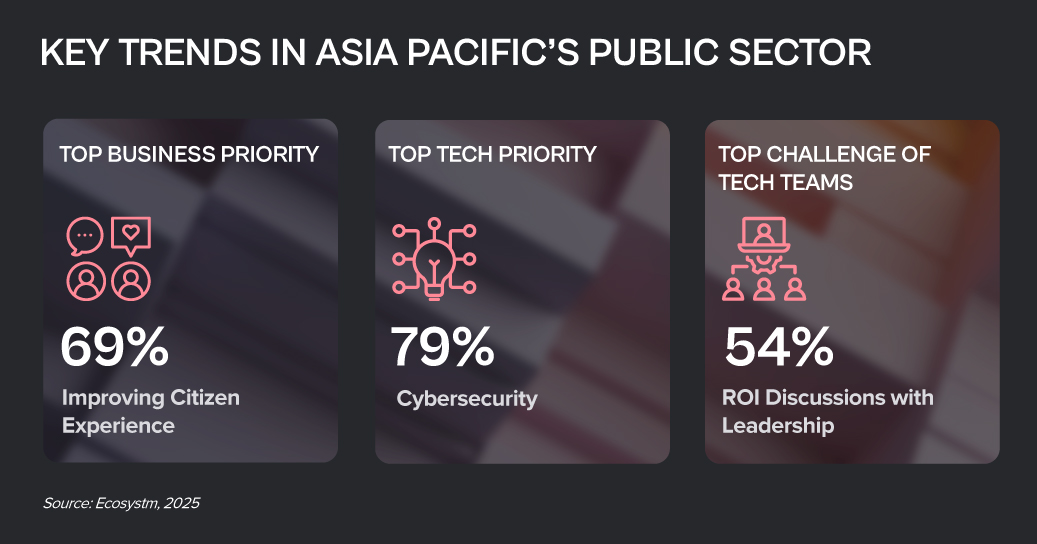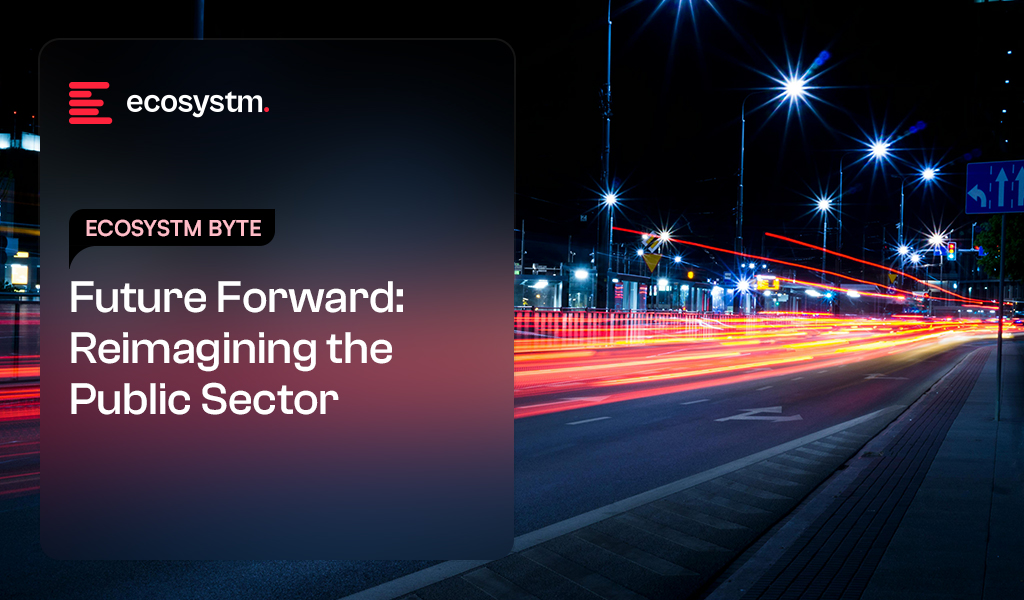As rapid technological change, rising citizen expectations, and growing demands for efficiency and transparency converge, the public sector stands at a pivotal crossroads. Profound, system-wide transformation is no longer a future ambition – it is an urgent imperative. From streamlining services and optimising resources to strengthening engagement and building more resilient infrastructure, the challenges and opportunities facing governments are immense.
Now is the time to reimagine how innovation, technology, and a citizen-first mindset can come together to reshape the very fabric of the public sector.

Click here to download “Future Forward: Reimagining the Public Sector” as a PDF.
Smarter City Management with Digital Twin
GovTech Singapore faced challenges in managing data from smart infrastructure as part of its Smart Nation initiative. They needed a more efficient way to visualise and analyse data from sources like smart lamp posts to improve urban management and resource optimisation.
GovTech implemented a digital twin solution that integrates real-time data from environmental sensors and traffic cameras into a dynamic 3D visualisation platform, enhanced by AI-driven analytics for predictive maintenance and resource allocation.
This solution provided valuable operational insights, reduced maintenance costs, and improved responsiveness to urban challenges. It boosted scalability and performance, optimising city planning and advancing the Smart Nation initiative towards more sustainable and efficient urban development.
Digital Leap for Accessible Governance
Scattered across the Indian Ocean, the Maldives faced a major challenge: delivering government services to citizens spread over 1,000 islands without forcing them to travel. The Ministry of Environment, Climate Change and Technology aimed to build a digital economy that could bring essential services directly to every island, while cutting costs and supporting sustainability goals.
The Ministry unified government agencies on a single, secure digital platform, enabling cloud-based collaboration, virtual meetings, and streamlined access to services.
Now, 20,000 public servants collaborate online, reducing travel, paper use, and operational costs. Government services have become faster and more accessible, solar energy projects are managed more efficiently, and citizens can access services – from banking to legal hearings – without leaving their islands. With digitalisation now embedded, the Maldives is laying the groundwork for AI-driven innovation and further advances in sustainable governance.
Enhancing Urban Resilience
With rising flood risks and extreme weather, Melbourne Water needed a faster, smarter way to maintain its 4,000 stormwater grates. Manual inspections were slow, costly, and couldn’t keep up with intensifying storms. Crews struggled to inspect grates across 14,000 sq km, often arriving too late or checking clear grates. Frequent site visits drove up costs, safety risks, and stretched resources, while the city needed to scale inspections without overburdening crews.
Melbourne Water implemented a cloud-based image recognition system with real-time cameras, using AI to detect blockages and trigger work orders only when needed.
The system is expanding beyond trial sites to cover critical points in the drainage network, with early results showing tens of thousands in annual savings and further efficiency gains. By freeing up crews and reducing manual work, Melbourne Water is better prepared to manage flood risks and support the city’s sustainable growth.
Making the Cloud Shift to Address Bottlenecks
The Philippine national police force overhauled its outdated licensing system, where applicants endured weeks-long waits, repeated office visits, and costly delays. Staff were bogged down by manual checks, while on-prem systems struggled with capacity limits, poor scalability, and frequent outages.
By shifting to a cloud-native platform, processing times dropped from four weeks to 24 hours – a 96% improvement.
The system now handles 5x more applications daily, scaling automatically with demand. Secure cloud storage replaced legacy systems, freeing IT teams to focus on citizen services. A nationwide content network and built-in security keep access fast, reliable, and protected. The force is unifying IT on one cloud platform and rolling out disaster recovery to boost resilience and future-proof operations.
Streamlining Employee Services
The New Zealand Parliamentary Service needed a more efficient way to manage employee services. Previously reliant on 11 separate email inboxes and a third-party IT service desk, the system was slow, disjointed, and cumbersome. Onboarding and offboarding were a particularly time-sensitive challenge, often causing delays and frustrations.
To streamline operations, the service transitioned to a unified platform, consolidating services into a single portal.
This move cut response times from weeks to just two days and simplified access to essential services, improving employee satisfaction and operational efficiency. With real-time performance tracking and AI-driven case management, the Parliamentary Service is now equipped to scale and optimise service delivery as it continues its digital transformation.
Enhancing Weather Prediction
The Japan Meteorological Agency (JMA) faces the challenge of enhancing weather predictions, particularly for typhoons and torrential rains, as climate change increases their frequency and intensity.
JMA upgraded its supercomputing infrastructure to boost memory bandwidth and computational power, enabling higher-resolution forecasts and more accurate predictions for linear precipitation zones.
The result: JMA has improved the resolution of its local weather models, extending the forecast time for local predictions from 10 to 18 hours. The new system has also increased prediction accuracy for linear precipitation zones, raising the probability of forecasting these events 15 hours in advance from 33% to higher levels. Additionally, the new infrastructure has reduced the number of nodes needed for some weather prediction models by up to 80%, optimising computational resources for other forecasting needs.














